Behind every successful product launch, campaign, or digital transformation sits a well-orchestrated plan. Project management isn’t just a way to keep tasks organized — it’s the discipline that allows businesses to turn ideas into positive outcomes. Without it, you risk seeing your deadlines slipping, budgets collapsing, and stakeholder trust eroding.
Within this field, two methodologies dominate the conversation: Agile and Waterfall. These approaches represent different ways of managing projects and distinct mindsets about how businesses should operate. Agile reflects adaptability and continuous feedback, while Waterfall relies on structure and predictability. Understanding both is important for any company deciding how to handle complex initiatives, from app development to global rebrands.
Agile Project Management: Definition and Principles
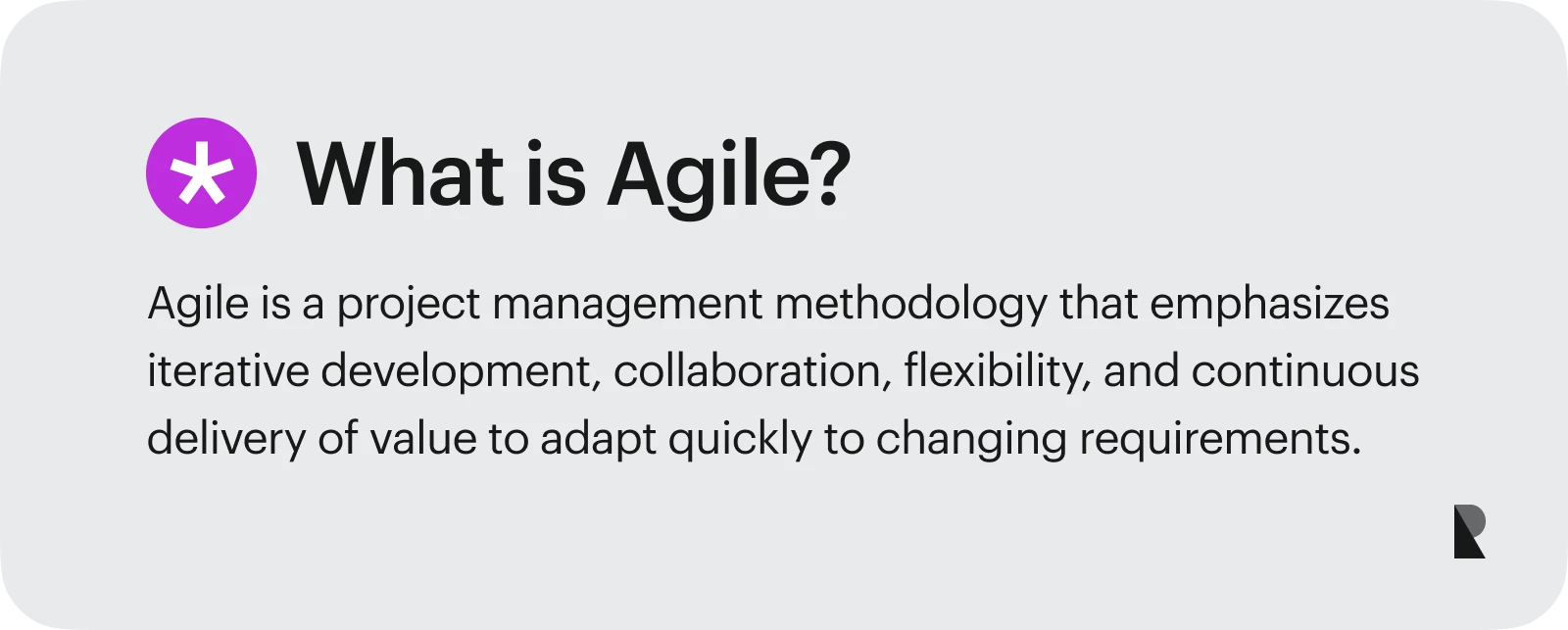
Agile methodology originally responded to the rigid structures of traditional project management. At its core, Agile emphasizes adaptability, customer collaboration, and incremental progress. It breaks down large projects into smaller, manageable units known as iterations or sprints. This creates a development process that can adjust to changing requirements without derailing the entire effort.
The foundation of Agile is based on principles like collaboration between team members, frequent delivery of working outputs, and openness to evolving feedback. Agile encourages transparency by consistently involving stakeholders throughout the development, making sure that alignment between business goals and execution is always kept in mind.
Agile in practice
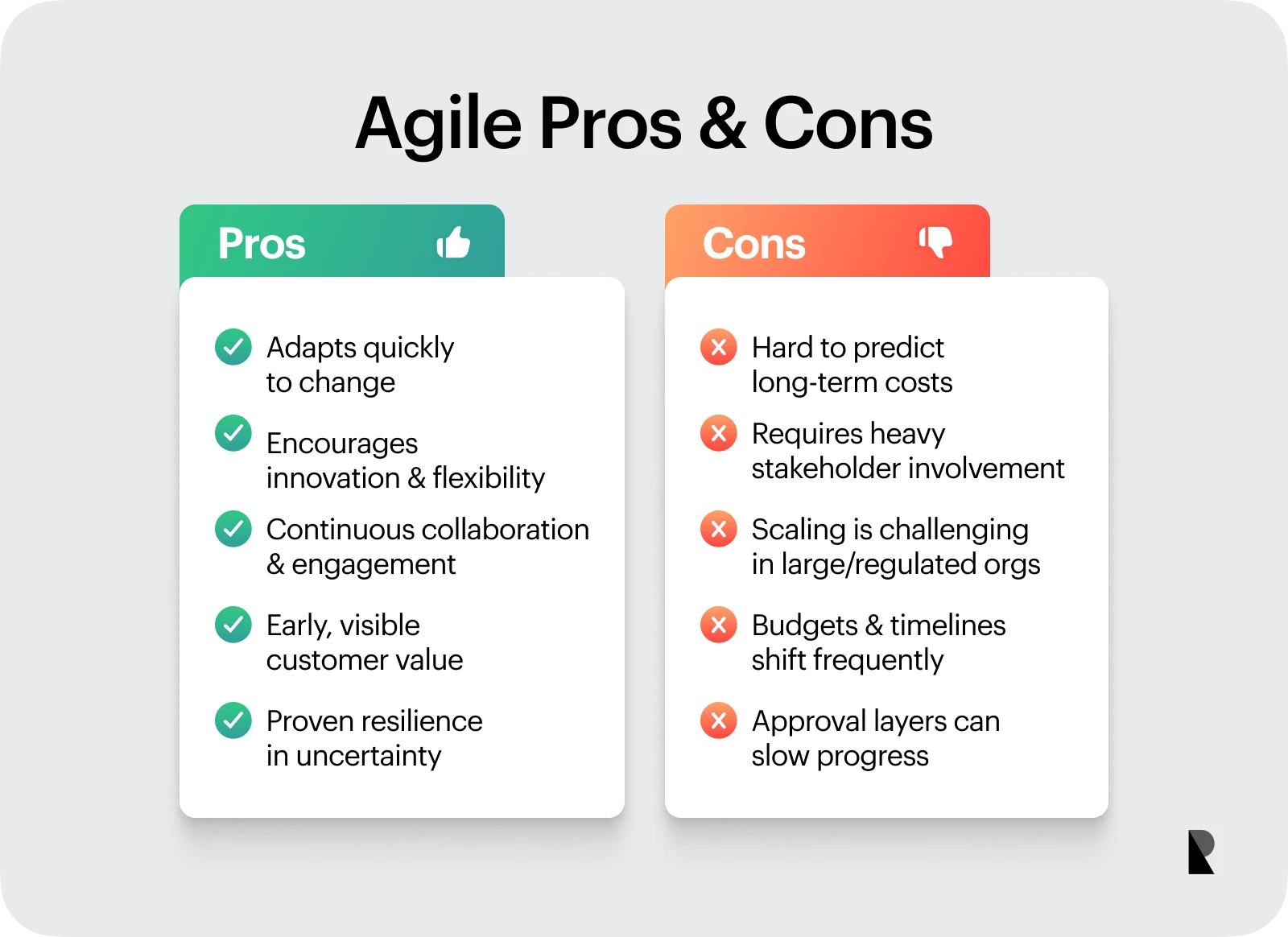
Agile projects are typically managed through frameworks like Scrum or Kanban. Scrum organizes work into short sprints, usually two to four weeks, with daily standup meetings that align agile teams. Retrospectives close each cycle, offering feedback loops that guide continuous improvement.
Kanban, in contrast, uses a visual board to map work in progress, limiting tasks at each stage to maintain focus and efficiency. Whether through Scrum or Kanban, the aim is to keep momentum steady while maintaining flexibility.
Pros of agile
Agile methodology allows organizations to adapt quickly to change, whatever that might look like. Welcoming evolving requirements enables businesses to innovate while still moving forward. Team members feel more engaged because collaboration is constant, and customers benefit from seeing progress early rather than waiting months for results.
This adaptability was evident during the pandemic. Research shows that nearly all agile business units outperformed their non-agile counterparts, achieving stronger customer satisfaction, higher employee engagement, and more resilient operations. Agile allows businesses to navigate uncertainty by turning flexibility into an advantage.
Cons of agile
That said, Agile also has its challenges. Predicting long-term costs can be difficult because budgets and timelines shift alongside changing requirements. Stakeholders must be actively involved, which demands a lot of time and commitment. Scaling Agile across large organizations or highly regulated industries can also create friction, especially when every detail has to pass through layers of approval.
Waterfall Project Management: Definition and Principles
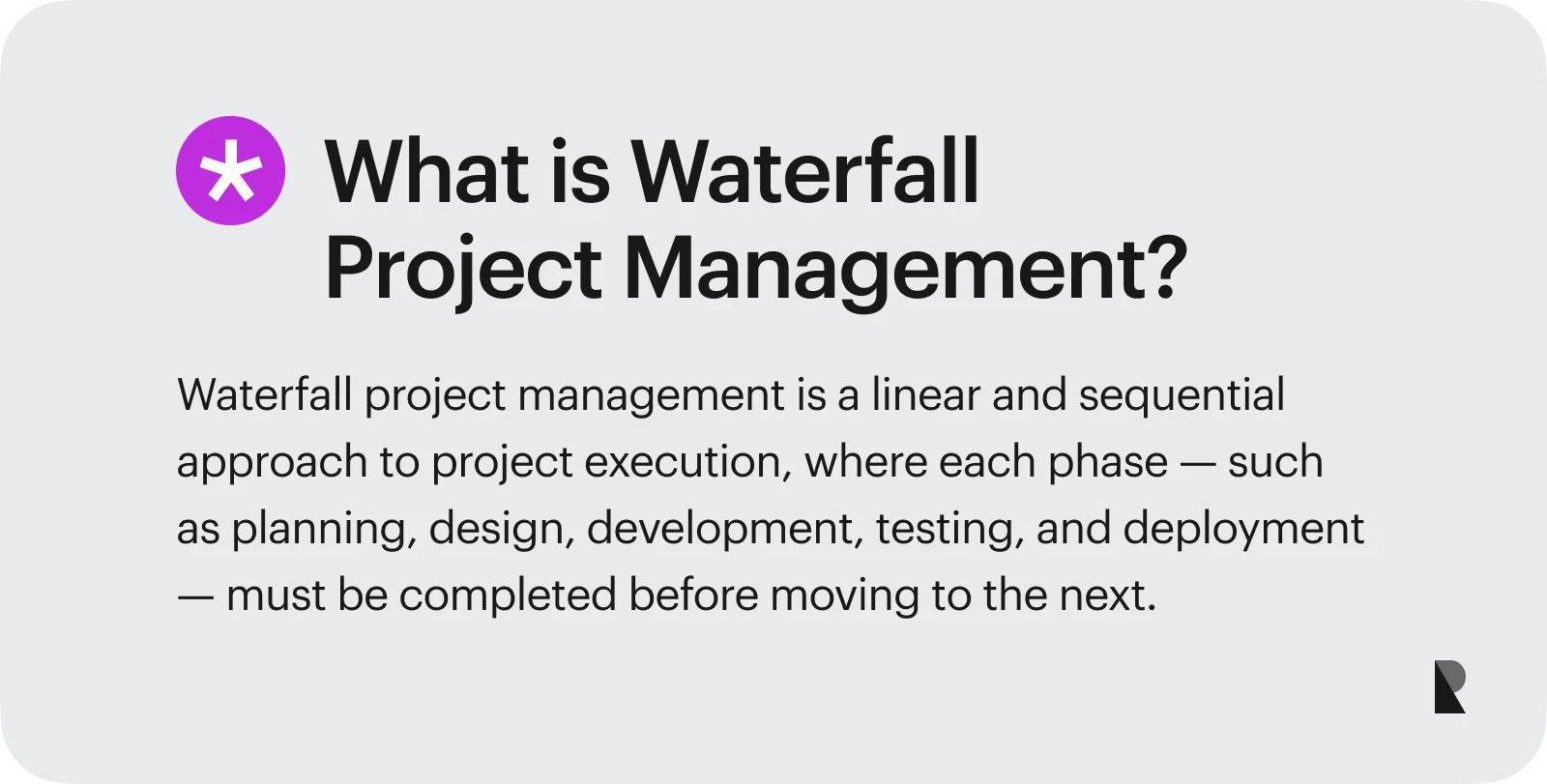
Waterfall methodology is the older, more traditional approach. It follows a linear path: requirements gathering turns into design, which flows into implementation, testing, and deployment. Each phase is completed in full before the next one begins, creating a structured approach that leaves little room for deviation once underway.
The waterfall model is built for clarity and predictability. Every stage depends on clearly defined requirements established at the beginning. This helps ensure that everyone — from stakeholders to developers — understands the final product before any code is written or designs are drafted.
Waterfall in practice
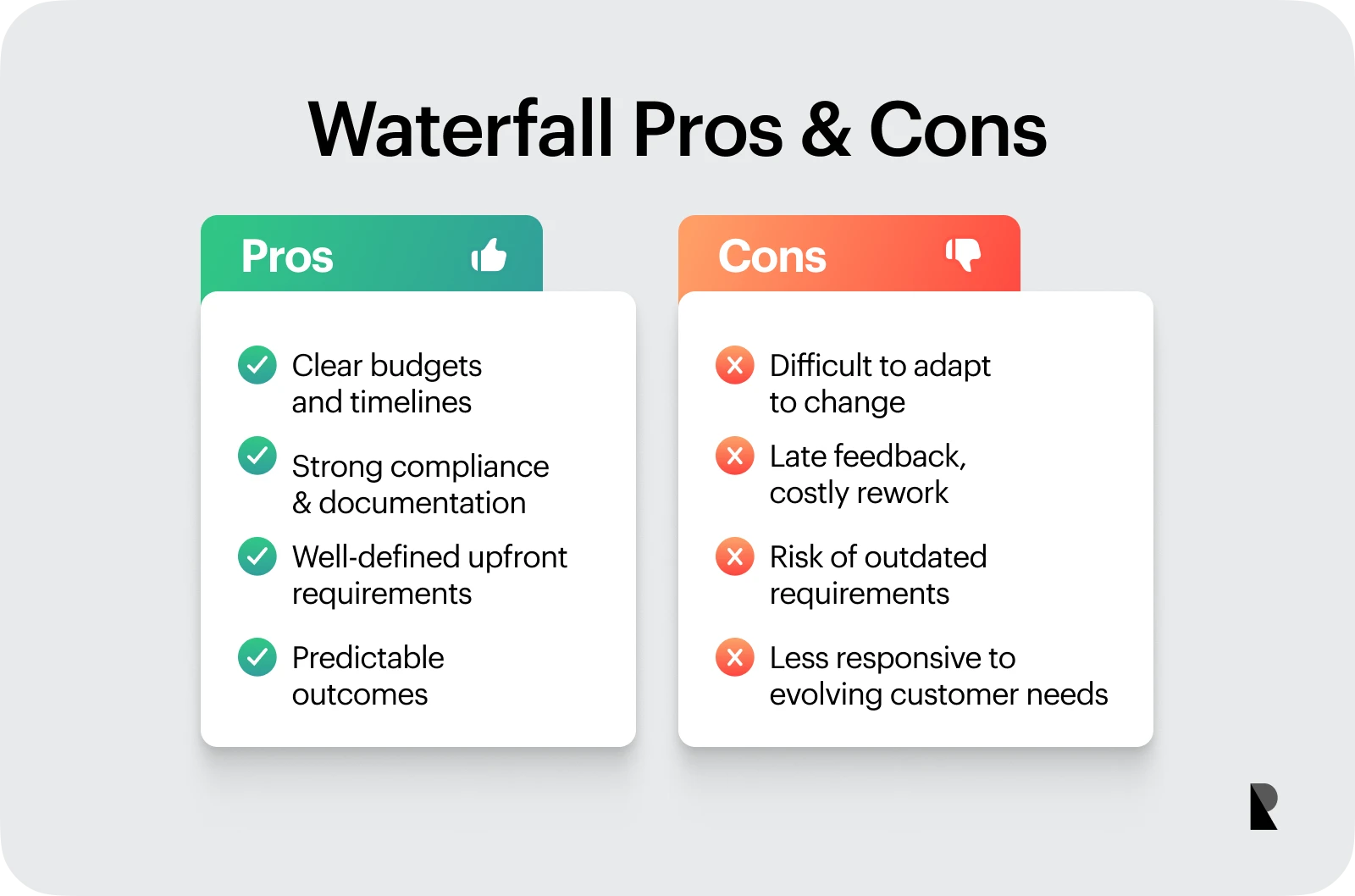
In practice, Waterfall projects resemble a sequence of gates. Planning outlines the full scope and budget. Design turns concepts into detailed blueprints. Implementation brings those designs to life, followed by rigorous testing before the project is released. Once deployed, changes are costly and disruptive, which is why the upfront planning phase is so extensive.
Pros of waterfall
Waterfall methodology shines in environments where predictability is essential. Budgets and timelines are mapped out early, giving stakeholders clarity on what to expect. For industries where compliance and documentation are crucial, the waterfall methodology provides the discipline and transparency needed to meet regulatory standards.
Because most of the requirements are established upfront, stakeholders clearly understand the project outcome. This reduces ambiguity, making Waterfall attractive for projects with fixed deliverables such as government contracts or infrastructure builds.
Cons of waterfall
The very structure that provides predictability can also become a limitation. Once a project is in motion, introducing changes is difficult without causing delays or exceeding the budget. Feedback loops occur late in the cycle, so discovering errors or misalignments can lead to costly rework. Waterfall projects may also struggle to meet customer needs if those evolve during development, leaving teams locked into outdated requirements.
Agile vs Waterfall: The Key Differences
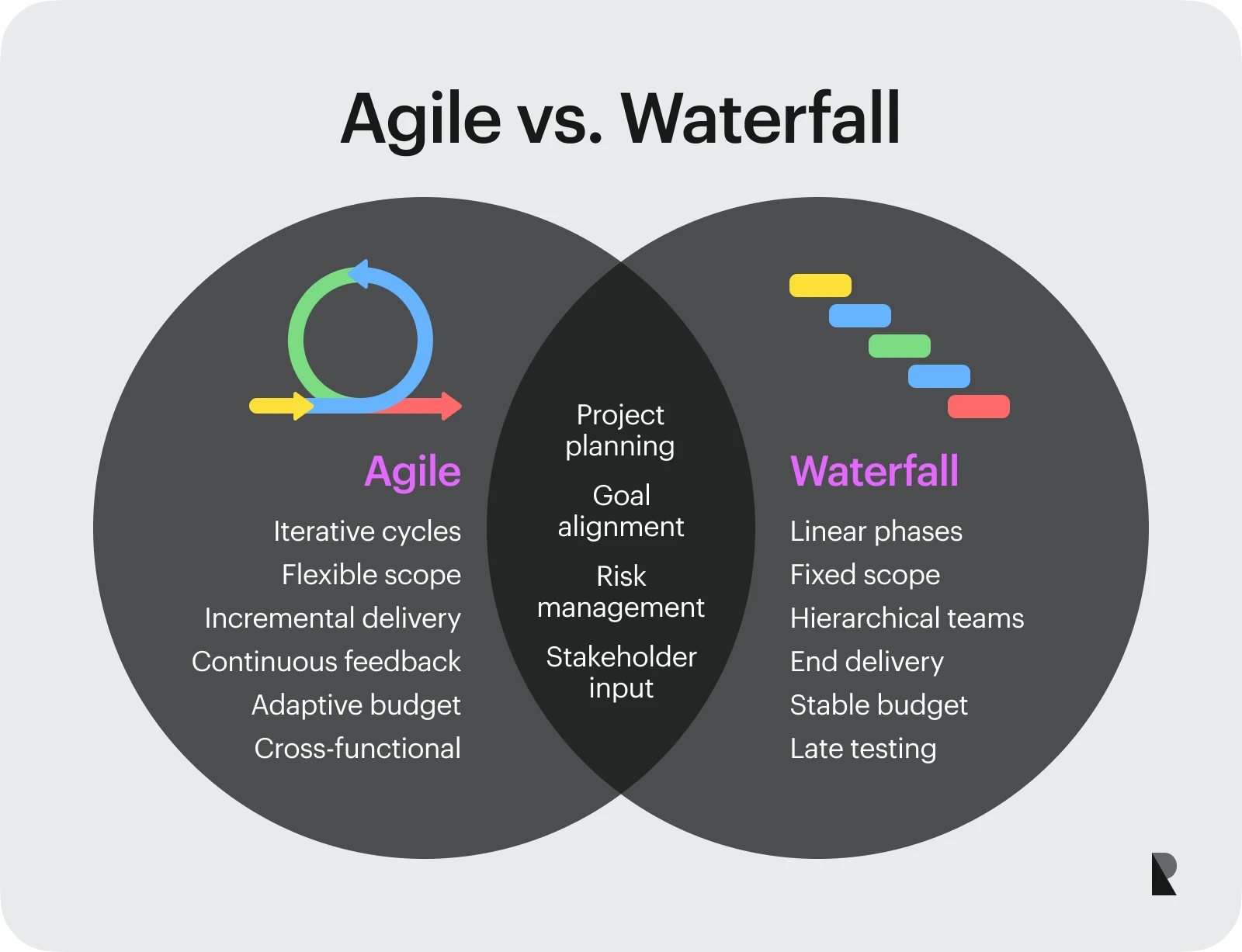
Agile and Waterfall are in contrast, not only in how they are executed but also in how they reflect different business philosophies. Where Agile thrives on adaptability, Waterfall values stability. Where Agile embraces uncertainty, Waterfall manages risk by removing it upfront.
To understand their differences more clearly, looking at specific dimensions of project management might be helpful.
Project planning and requirements
Agile methodology treats requirements as living elements. They can evolve throughout development and be shaped by stakeholder feedback and customer needs. This makes Agile projects well-suited for dynamic markets where flexibility is more valuable than certainty.
On the other hand, the waterfall methodology begins with fixed requirements. Once agreed upon, these serve as the guiding blueprint for the rest of the project. This provides structure and reduces ambiguity, but leaves little room to adapt if business goals shift.
Flexibility and adaptability
Agile provides flexibility by design. Its iterative cycles allow teams to incorporate changes quickly, ensuring outputs remain aligned with real-world demands. Agile encourages learning and adjusting as projects unfold, which can spark innovation.
Waterfall projects, however, follow a rigid path. Adaptability is limited, as making adjustments late in the cycle often means rewriting months of work. This structured approach is efficient for stable environments but restrictive in fast-moving industries like software development.
Team structure and collaboration
One of the most striking differences between Agile and Waterfall is how they look at collaboration.
Agile teams are cross-functional and self-organizing. Designers, developers, and testers work closely together, often sharing responsibilities instead of remaining locked in separate silos. This dynamic encourages ownership, accountability, and creativity. Agile encourages team members to communicate openly, often through daily standups and frequent reviews, so everyone remains aligned.
Waterfall projects rely on a more hierarchical structure. Each stage is often assigned to a specialized group, with handoffs occurring once their portion of the work is complete. This provides clarity on roles and responsibilities, but it can also limit collaboration between disciplines. Misalignments often surface late in the project, when it’s much harder to fix them.
Risk management
Agile project management reduces risk through incremental progress. Each iteration produces a tangible output, allowing issues to be identified and resolved early on. Frequent feedback loops with stakeholders create a system where potential problems are surfaced before they grow into major setbacks.
Waterfall methodology approaches risk differently. Because testing occurs after most of the work is completed, many risks only emerge at the end. If fundamental assumptions prove wrong, adjustments can become expensive. This late-stage discovery is a key reason why Waterfall projects sometimes run over budget or fail to meet expectations.
Costs and budgeting
For organizations with strict budgets, Waterfall can feel safer. Because requirements are locked in from the beginning, financial estimates remain stable. This makes the waterfall model appealing for projects where predictability outweighs the need for adaptability, such as government infrastructure or defense contracts.
Agile projects handle budgets differently. Because priorities can shift, cost estimates often evolve. While this unpredictability can frustrate some stakeholders, it also means resources are invested in the most relevant areas. Agile allows reallocating budgets dynamically to match business value rather than being bound to an outdated plan.
Timelines and delivery
Waterfall methodology delivers everything at the end. Stakeholders receive the finished product only once all phases are complete. While this single release can create a dramatic launch, it also means waiting months — or even years — before seeing results.
Agile, on the other hand, delivers incrementally. Each sprint ends with a usable outcome, even if small. This enables stakeholders to witness progress throughout the development and provide feedback early. Continuous improvement is baked into the process, creating more opportunities to refine outputs as the project unfolds.
Choosing Between Agile and Waterfall
Both methodologies have value, and choosing the right one for your project depends heavily on the type of project, the industry, and your business goals.
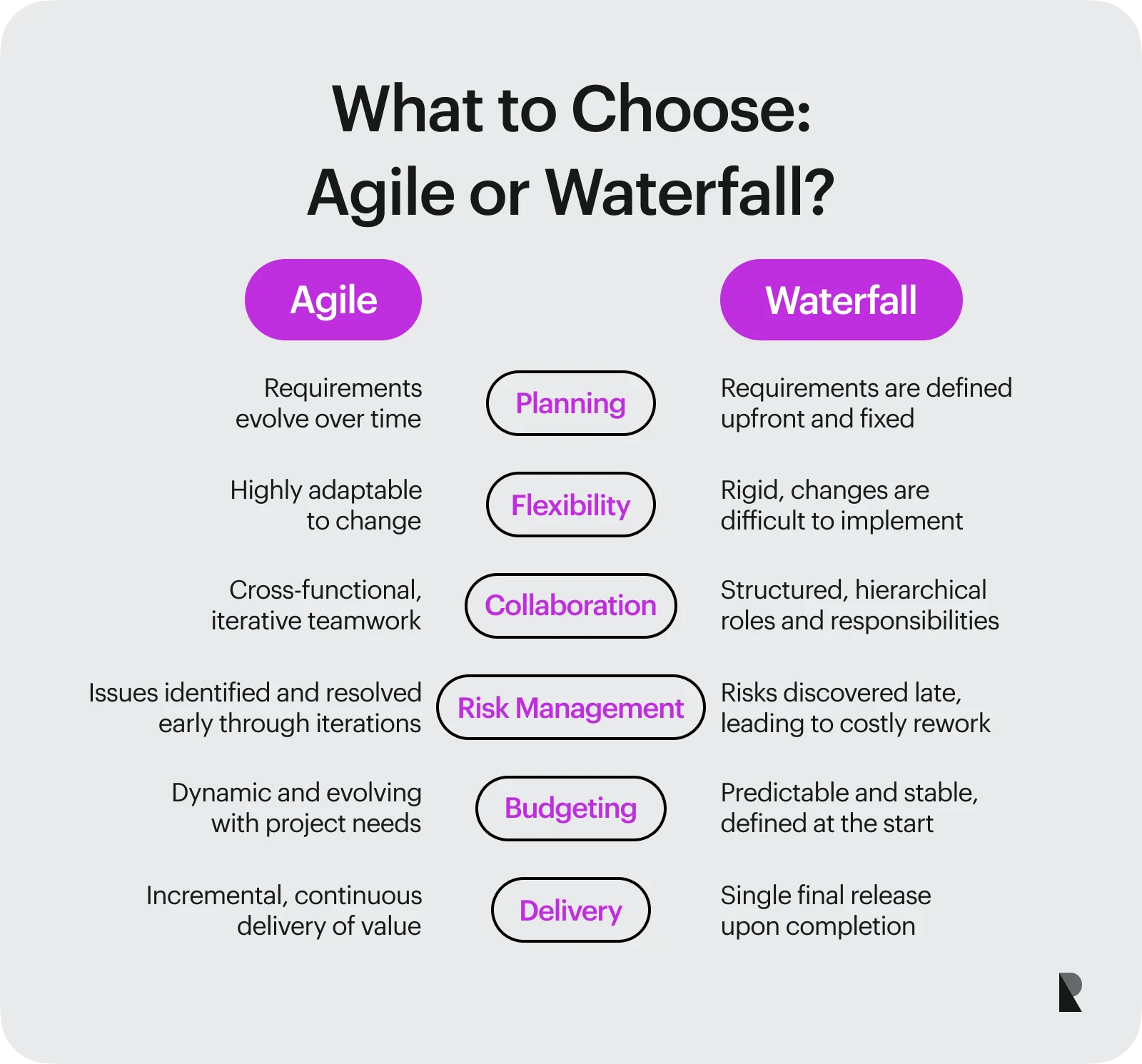
Agile is often the right choice for software development, creative projects, or industries where changing requirements are inevitable. Agile provides adaptability and closer stakeholder collaboration, which are crucial when speed and innovation matter.
Waterfall is more effective in environments where precision and compliance dominate. Construction projects, aerospace engineering, and significant infrastructure investments benefit from a structured approach where requirements and budgets are defined.
To visualize the comparison, consider the following.
| Factor | Agile | Waterfall |
|---|---|---|
| Planning | Evolving requirements | Fixed requirements |
| Flexibility | High adaptability | Rigid structure |
| Collaboration | Cross-functional teams | Hierarchical roles |
| Risk management | Early detection, iterative fixes | Late discovery, costly rework |
| Budgeting | Dynamic and evolving | Predictable and stable |
| Delivery | Incremental, continuous | Final release only |
Hybrid Project Management: Combining Agile and Waterfall
In recent years, many organizations have moved beyond the binary choice of Agile vs Waterfall and adopted hybrid approaches. These aim to blend the predictability of Waterfall with the adaptability of Agile.
For example, an enterprise company might use the Waterfall methodology for high-level planning and budgeting, ensuring clarity for stakeholders, while applying the Agile methodology within development teams to deliver flexibility. This combination creates a nice balance — long-term stability paired with short-term adaptability.
Hybrid models are not without challenges, though. They require careful coordination so that agile teams working iteratively do not clash with the structured expectations of waterfall projects. Misalignment between departments can lead to confusion, especially if stakeholders expect both predictability and flexibility simultaneously. Still, when executed well, hybrid approaches allow businesses to capture the best of both worlds.
Conclusion
Project management defines how ideas become reality, and the choice between Agile and Waterfall plays a significant role in that journey. Agile methodology thrives on adaptability, continuous improvement, and stakeholder collaboration. It helps organizations adjust quickly and maintain resilience in uncertain markets. Waterfall methodology, in contrast, emphasizes structure, clarity, and predictability — qualities vital for projects where compliance, budgets, and precision dominate.
Agile projects provide speed and flexibility, while Waterfall projects offer stability and control. Their decision depends on project type, organizational culture, and industry requirements. For many, a hybrid approach might actually unlock the ideal balance.
When evaluating options, remember that methodologies are tools, not dogmas. Choosing the right one requires aligning with goals, resources, and stakeholders' expectations. Hiring a skilled app development agency for companies seeking outside expertise can help identify the best approach, ensuring that methodology and execution are tailored to the challenge.
Ultimately, the debate between Agile vs Waterfall is less about which is better and more about which is better for you. Success doesn’t come from rigidly adhering to one philosophy, but from applying the right approach at the right time.
Sep 29, 2025
